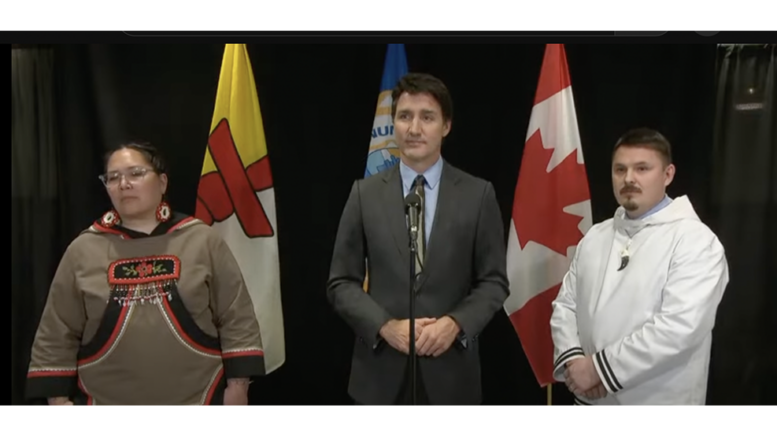By Jeremy Appel, Local Journalism Initiative Reporter
(ANNews) -At a Jan. 18 Iqaluit ceremony, Prime Minister Justin Trudeau, Nunavut Premier P.J. Akeeagok and Nunavut Tunngavik Inc. president Aluki Kotierk signed an agreement that constitutes the largest land transfer in Canadian history.
Covering two million square miles of land and water, the agreement gives the territorial government final say over land and resource decisions that were previously the purview of the Canadian government, finalizing a process that began well before Nunavut became a territory 25 years ago.
The devolution agreement, which goes into effect in April, will be implemented over the next three years. Yukon and Northwest Territories have similar agreements with the feds, which went into effect in 2003 and 2014, respectively.
“It’s high time. It’s a turning point for Nunavummiut,” Paul Quassa, a former Nunavut premier and land claims negotiator, told CBC News.
He added that this moment, which he’s been waiting for since Nunavut became part of confederation, is “like honey … sweet.”
Speaking to reporters before the ceremony, Trudeau called the signing of the agreement an “historic” day for Canada and Nunavut.
“Leaders, negotiators, officials of many stripes have all worked hard for many years for the same goal: for Nunavummiut to have increased control for decisions on their land, waters and resources,” said the prime minister.
To provide Nunavut with the resources needed to take on its added jurisdictional responsibilities, the feds will provide the territory with an additional $85 million in annual funding, as well as one-time funding of $67 million for transitional activities and $15 million for training.
One of the final areas to be negotiated was land and water management, which includes resource development, with that process beginning in 2008.
An agreement-in-principle was reached in 2019, with the time since then spent hammering out particular details.
Under devolution, the territorial government will have final say on the development of minerals, oil and gas on Nunavut public lands, and give the territory the ability to collect royalties from resource extraction.
“We’ll decide our own future,” Premier Akeeagok said. “Before this, it was Ottawa who had the final decision over whether a project would advance.”
The agreement establishes the terms for transferring Crown land and resources to the territorial government, outlining conditions for the post-transfer era.
Once the transfer is complete, Government of Canada employees in Nunavut whose jobs are now territorial jurisdiction will be offered jobs with the territorial government.
Under Article 23 of the 1993 Nunavut Agreement, the federal and territorial governments must ensure Inuit people are employed in federal and territorial government roles in Nunavut proportionate to their share of the territory’s population.
The role of Nunavut Tunngavik Inc. is to develop a human resources strategy specifically focused on increasing Inuit employment, something the territory has struggled with.
Increasing their share of government jobs will ensure “Inuit shape the policies and future of land and resource development in Nunavut,” Nunavut Tunngavik Inc. president Kortiek said in a Jan. 18 statement.
Former Nunavut premier Joe Savikataaq, who served from 2018 to 2021, told the CBC that the devolution agreement’s signing marks the beginning of a “long, drawn out process,” representing “another step in Nunavut growing up.”
Savikataaq, who still represents Arviat in the Legislative Assembly, cautioned that the new government jobs cannot be concentrated in the capital city.
“Not all the jobs should be going to Iqaluit. We should be seeing jobs in communities,” he said.



Be the first to comment on "Canada and Nunavut sign long-awaited devolution agreement"